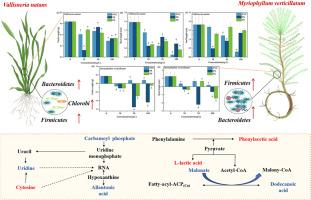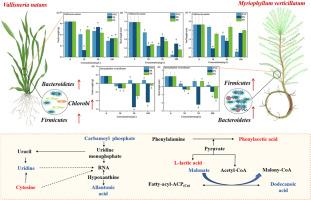微塑料在水生生态系统中的毒性机制:以水蛭藻和黄斑狐尾藻为例
IF 7.3
2区 环境科学与生态学
Q1 ENVIRONMENTAL SCIENCES
引用次数: 0
摘要
微塑料(MPs)已成为各种生态系统中普遍存在的污染物,水生环境越来越被认为是主要的汇。然而,MPs对沉水植物的生态风险和毒性作用仍然知之甚少。本研究考察了三种常见MPs的影响,包括聚氯乙烯(PVC)、聚苯乙烯(PS)和聚乙烯(PE)在不同浓度下(10mg/L;50 mg / L;100mg/L)对两种沉水植物水草(Vallisneria natans)和verticillatum肉豆芽(Myriophyllum verticillatum)的作用。结果表明,MPs显著抑制沉水植物的生长,引发抗氧化反应,并造成膜损伤。代谢组学分析显示,PVC MPs破坏了V. natans的关键代谢途径,包括嘧啶代谢、丙氨酸、天冬氨酸和谷氨酸代谢,以及β-丙氨酸的降解。此外,MPs降低了水中的溶解氧(DO)和氧化还原电位(ORP)水平,促进了沉积物和生物膜中拟杆菌门(Bacteroidetes)、厚壁菌门(Firmicutes)和Chloroflexi的增殖。这些发现表明,MPs对沉水植物的毒性机制主要涉及水质退化、沉积物和生物膜中优势微生物丰度的变化以及植物体内生理和代谢紊乱。该研究为MPs在水生生态系统中更广泛的生态影响提供了新的见解。本文章由计算机程序翻译,如有差异,请以英文原文为准。


Unraveling the toxic mechanisms of microplastics in aquatic ecosystem: A case study on Vallisneria natans and Myriophyllum verticillatum
Microplastics (MPs) have become ubiquitous pollutants in diverse ecosystems, with aquatic environments increasingly identified as major sinks. Nevertheless, the ecological risks and toxic effects of MPs on submerged macrophytes remain poorly understood. This study examined the impacts of three common MPs including polyvinyl chloride (PVC), polystyrene (PS) and polyethylene (PE) at varying concentrations (10 mg/L; 50 mg/L; 100 mg/L) on two submerged plant, Vallisneria natans (V. natans) and Myriophyllum verticillatum (M. verticillatum). The results demonstrated that MPs significantly inhibited the growth of submerged macrophytes, triggered antioxidant responses, and caused membrane damage. Metabolomics analysis revealed that PVC MPs disrupted key metabolic pathways, including pyrimidine metabolism, alanine, aspartate, and glutamate metabolism, as well as β-alanine degradation in V. natans. Furthermore, MPs reduced dissolved oxygen (DO) and oxidation-reduction potential (ORP) levels in the water, promoting the proliferation of Bacteroidetes, Firmicutes, and Chloroflexi in sediments and biofilms. These findings suggest that the toxic mechanisms of MPs on submerged macrophytes primarily involve water quality degradation, shifts in the abundance of dominant microorganisms in sediments and biofilms, and the induction of physiological and metabolic disturbances within the plants. The study provides new insights into the broader ecological implications of MPs in aquatic ecosystems.
求助全文
通过发布文献求助,成功后即可免费获取论文全文。
去求助
来源期刊

Environmental Pollution
环境科学-环境科学
CiteScore
16.00
自引率
6.70%
发文量
2082
审稿时长
2.9 months
期刊介绍:
Environmental Pollution is an international peer-reviewed journal that publishes high-quality research papers and review articles covering all aspects of environmental pollution and its impacts on ecosystems and human health.
Subject areas include, but are not limited to:
• Sources and occurrences of pollutants that are clearly defined and measured in environmental compartments, food and food-related items, and human bodies;
• Interlinks between contaminant exposure and biological, ecological, and human health effects, including those of climate change;
• Contaminants of emerging concerns (including but not limited to antibiotic resistant microorganisms or genes, microplastics/nanoplastics, electronic wastes, light, and noise) and/or their biological, ecological, or human health effects;
• Laboratory and field studies on the remediation/mitigation of environmental pollution via new techniques and with clear links to biological, ecological, or human health effects;
• Modeling of pollution processes, patterns, or trends that is of clear environmental and/or human health interest;
• New techniques that measure and examine environmental occurrences, transport, behavior, and effects of pollutants within the environment or the laboratory, provided that they can be clearly used to address problems within regional or global environmental compartments.
 求助内容:
求助内容: 应助结果提醒方式:
应助结果提醒方式:


